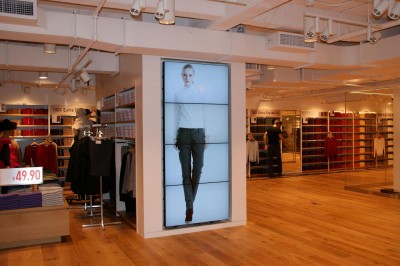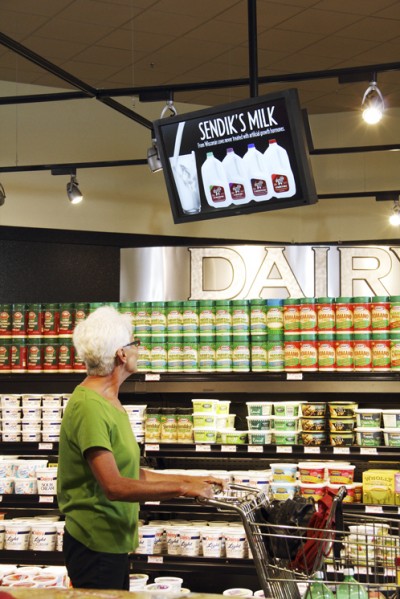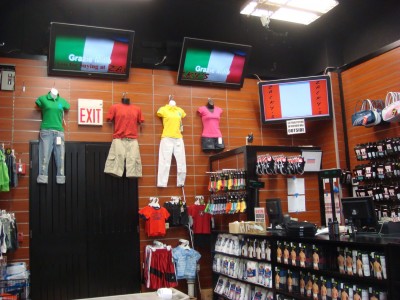Measuring the advantages of dynamic retail displays
by Matthew | 24 January 2012 9:30 am
 [1]
[1]Photos courtesy NEC Display Solutions
By Richard Ventura
According to iSuppli, a market research firm, shipments of digital signage displays to the retail sector are expected to triple by 2013, compared to 2011 numbers. This is an encouraging forecast during a time of economic uncertainty.
Yet, it is important to keep in mind a digital signage rollout will not automatically transform a particular retail store or chain for the better. Rather, the deployment must be accompanied by a thoughtful approach, with consideration given to such factors as screen installation locations, digital signage content and how the retailer chooses to engage its customers.
To help align various interests, it is especially important to understand how the use of digital signage in retail differs from other vertical markets. And finally, to begin calculating the deployment’s return on investment (ROI) requires the knowledge of how to measure the success of the project.
Flavours of content
By now, it should go without saying: ‘content is king.’ If retailers do not have the right content running on their digital signs, their investment in the medium will not attract its target audiences and shape their purchasing decisions.
 [2]
[2]Sendik’s Food Markets have used digital screens to eliminate the outsourced printing of in-store signs. Their product prices can now be updated in minutes.
Content comes in different ‘flavours’ and can become all the more relevant when it reflects the ways a retail establishment already engages its customers.
‘Active’ content seeks to engage passersby with direct messages and a ‘call to action.’ Thus, the goal of active content is to attract customers to a screen and lead them to perform a subsequent action that will help increase the retailer’s sales.
‘Passive’ content comprises elements like background images and sound, through which atmosphere is created to help attract customers to the retail establishment and keep them there for longer. Music videos are one example of passive content.
Many retailers strike a balance between active and passive content. One section of a screen will run a video clip, for example, while another will direct the customer to various specials in the store.
‘Interactive’ content is less common, but allows a user to directly access information and other resources related to the store. Interactive digital signage, including kiosks and touch screens, can help draw customers in and align them with a retail brand on a one-to-one basis. This is key in increasing sales, building brand equity, enhancing customer relationships and achieving other business objectives. Additional options include interacting through social media and networks.
Locations for installations
The issue of where to install digital signs in a retail environment may seem at first like a simple consideration, but requires strategic planning that too many organizations fail to tackle. The retailer needs to consider where digital signage can get the most bang for the buck and how, specifically, sales are going to be driven.
In some cases, screens will be mounted just inside the doors of the store. In others, they are more effective in or near specific zones, like clothing fitting rooms. These installation decisions are contingent on where the retailer feels its customers are most likely to make purchasing decisions about its products.
The retail difference
As mentioned, the use of retail digital signage differs noticeably from applications in other industries. Indeed, there is much retailers can learn from those differences.
 [3]
[3]Some of the more progressive vendors are installing multi-screen video walls for a greater ‘wow’ factor.
In an airport, for example, digital signage is used to deliver flight information, along with some third-party advertising, news and other passive content. In a retail store, on the other hand, digital signage is usually 100 per cent dedicated to building the store’s brand and that of its products. Ads for Best Buy will not show up, for instance, on a Walmart screen network.
Another difference is customers tend to see a lot more dynamic content in retail settings than elsewhere, whether this entails full-motion video, animation or basic motion, potentially with audio content, as well. In fact, retail digital signage is nearly unique today in using background music, brand-specific sound effects, spoken word and other audio elements. These have proven compelling in helping drive sales.
Given these factors, as well as the diversity of potential content, one of the greatest opportunities anywhere in the digital signage industry has been the ability to affect retail sales. When a typical big-box store incorporates entertaining video and messaging to pique interest in its products, for example, it can showcase different brands of products and services to get consumers interested in them.
That scenario does not exist in quick-service restaurants (QSRs), by comparison, where digital signs may also be used for entertainment, but primarily take the form of less motion-heavy menu boards, featuring promotions to help trigger the upselling of food and drink items. With this different approach, they are less focused on conveying an experience related to their products.
Today’s progressive retailers are putting digital screens up where they can increase sales of certain items and help trigger impulse buying. Some are also installing video walls for more of a ‘wow’ factor within their store.
On the interactivity front, they are using both customized large-screen applications and smaller kiosks to allow consumers a measure of control. Customers’ smart phones can scan codes for coupons and special promotions, for example, and other deals may be offered through Twitter or Facebook. Compared to other sectors, interactivity is already becoming a central approach for retailers in terms of building customer relationships and achieving further growth.
 [4]
[4]Shipments of digital signage displays to the retail sector are expected to triple over the next year, relative to 2011.
Measuring success
There are several ways to measure the success of a retail digital signage network. A store’s point-of-sale (POS) system, for example, will show whether or not there is an increase in sales as a result of digital signage content.
Another measure of success is finding related savings. Sendik’s Food Markets, for example, have used digital signage to eliminate the outsourced printing of in-store signs, where costs had been rising and the process was becoming more arduous to manage. The grocery chain had found its sales were nearly over by the time the printed signs were delivered and installed. Digital signage allowed the shipping and in-store labour costs to be avoided altogether. And store item prices can now be updated in minutes, in line with market pressures.
Other new methods for effectively measuring the impact of retail digital signage are coming to the forefront. Semiconductor chipmaker Intel and a host of software companies have developed audience measurement systems, which collect aggregate data about the people looking at digital signs. By tracking what element capture their attention, along with their buying habits, this process can help the retailer determine which content is right to run where and what level of interactivity will favourably affect the bottom line.
If a retailer knows, for example, teenage girls are its biggest in-store audience between 3 p.m. and 5 p.m. on weekdays, then it can better tailor its digital signage content during those hours to those girls’ needs, using more of a one-to-one marketing relationship to help maximize opportunities for them to make purchases.
Such knowledge and technological capabilities are paving the way for retailers to succeed in driving sales further in the future.
Richard Ventura is director of vertical solutions sales for NEC Display Solutions. For more information, contact him via e-mail at rventura@necdisplay.com[5] or visit www.necdisplay.com[6].
- [Image]: http://www.signmedia.ca/wp-content/uploads/2014/02/DSC05776.jpg
- [Image]: http://www.signmedia.ca/wp-content/uploads/2014/02/Sendiks_102_RGB_72.jpg
- [Image]: http://www.signmedia.ca/wp-content/uploads/2014/02/auto.jpg
- [Image]: http://www.signmedia.ca/wp-content/uploads/2014/02/Zackys-9.jpg
- rventura@necdisplay.com: mailto:%20rventura@necdisplay.com
- www.necdisplay.com: http://www.necdisplay.com
Source URL: https://www.signmedia.ca/measuring-the-advantages-of-dynamic-retail-displays/